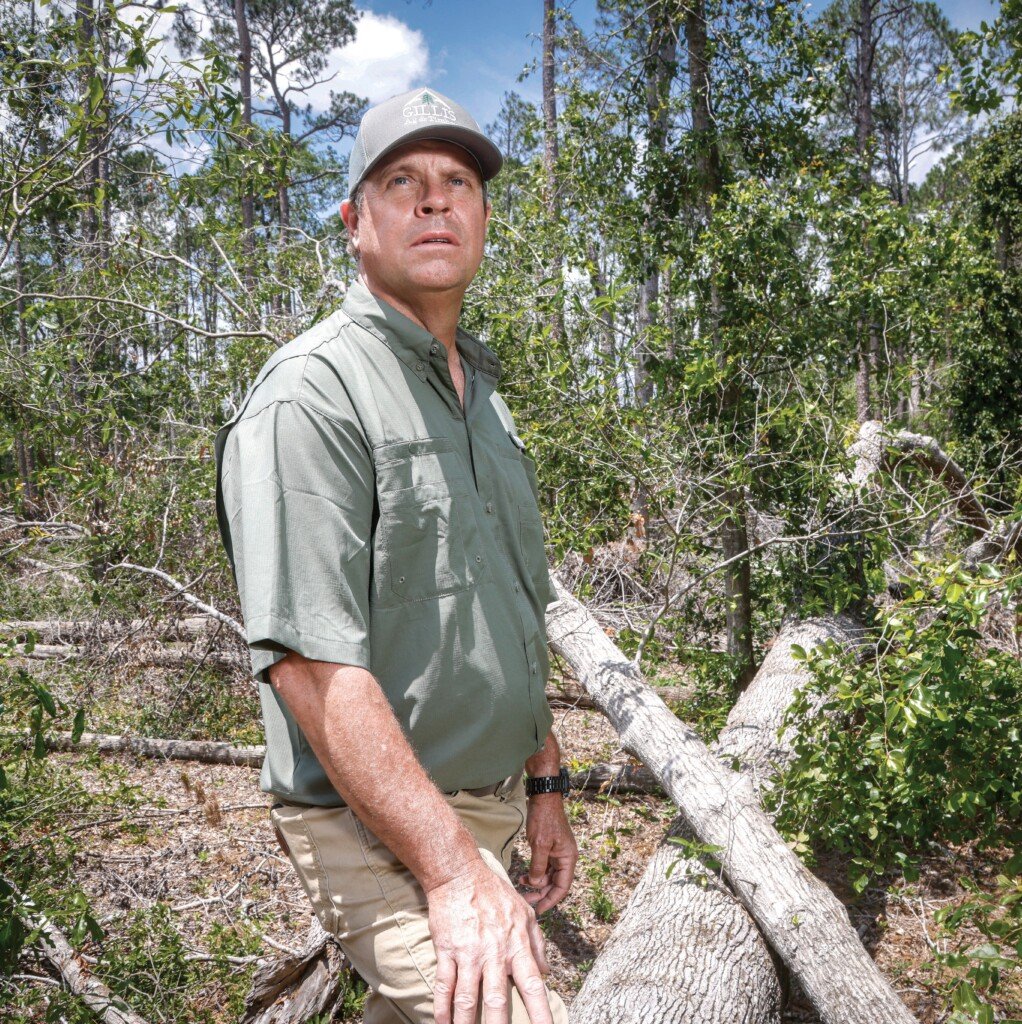Cliffhanger: Georgia’s Film Industry
After simultaneous writer and actor strikes in 2023, Georgia looks to the future of the ever-changing film industry.
Georgia’s blockbuster film industry had a major slump in 2024 that has continued into this year. No one knows whether it’s just an intermission before taking off again or a weak second act that will linger for years.
“You could see the growth of Georgia as a filming spot until 2022, that was sort of the peak,” says Marty Lang, the University of Georgia director of graduate studies in film, television and digital media. “And then after that, you could you start seeing things coming down a little bit.”
Up to that point, the industry had been growing steadily, mainly due to the state’s film tax credit, which was introduced in 2005 for production companies that met certain qualifications.
Georgia now has more than 4.1 million square feet of soundstage space, with 1 million of that built since 2021. That places Georgia No. 2 in stage space nationwide, surpassed only by California.
Georgia’s film production expenditures had gone from approximately $1.7 billion in fiscal year 2015 (July 1, 2014 – June 30, 2015) to around $2.9 billion in FY 2019, according to a 2023 report produced for the Georgia Screen Entertainment Coalition, an affiliate of the Georgia Chamber of Commerce. The report was funded by the coalition itself and the Georgia Production Partnership, made up of producers, directors, actors, crew members, business leaders and policy makers.
COVID-19 dropped film production investment in the state to $2.16 billion in fiscal year 2020, but when studios relaunched film production in FY 2021, companies spent $4 billion, according to the report. That figure grew to nearly $4.4 billion in fiscal year 2022 before going down to $4.1 billion in FY 2023.

Staying Optimistic: Lee Thomas, deputy commissioner of the Georgia Film Office. Photo credit: Daemon Baizan
“At one point, coming out of the pandemic, we were one of the first markets to open, and we had 93 projects on the ground here. Unheard of,” says Lee Thomas, deputy commissioner of the Georgia Film Office.
Then a tsunami of forces hit the film industry, and Georgia has not recovered. Film production in fiscal year 2024 dropped to below pre-pandemic levels, with only $2.6 billion in industry expenditures reported.
In contrast to those 93 simultaneous projects, the Georgia Film Office’s website listed 24 projects in March.
Strikes and Disruptions
One of the biggest blows to the industry was a pair of overlapping labor strikes – one by the Writers Guild of America from May to September 2023 and the other by the Screen Actors Guild-American Federation of Television and Radio Artists from July to November 2023.
“If the actors go on strike, there’s nobody to put in front of the camera,” Lang says. “If the writers go on strike, there’s nobody to write the scripts that get shot.”
But it wasn’t just the strikes. Media company mergers and consolidations as well as reduced budgets for streaming services led to fewer projects being approved.
“Like any industry, film contends with market realities,” says Kelsey Moore, executive director of the Georgia Screen Entertainment Coalition. “The film industry as a whole continues to recalibrate, reshaping itself after years of high rates of production boosted by the popularity of streaming platforms. In Georgia, we’re seeing direct spending by the film industry reflect the industry’s adjustment to new norms.”
UGA’s Lang, who has an office at Athena Studios, a state-of-the-art film and TV production facility in Athens with over 84,000 square feet of sound stages, can see the slowdown up close.
“Right now, there’s not as much production here as we would like,” he says. “There’s no question about it, but Georgia is not the only place that’s down. Worldwide, the industry is down 20%. In the United States, it’s down 40%. We’re doing better than most.”
Walker Dalton, executive director of the Savannah Regional Film Commission, cites a number of disruptions – low box office turnouts, changing viewing patterns and the globalization of the film industry as more companies shoot abroad.
Dalton and Lang both cite the Los Angeles fires from a few months ago, which crippled studios and distracted executives.

Career Kickstart: Eric Walters, a University of Georgia graduate student of Fine Arts in film, television and digital media, works on a project. Photo credit: Kai Morgan
“There’s been a lot of executives that have their minds in two places, their work and trying to find new places for their families,” Lang says.
Trilith Studios, the largest studio in Georgia, also has felt the slowdown. The 700-acre campus, which encompasses a 400-acre backlot and 1.5 million square feet of production space, also has 34 soundstages, including stages equipped for virtual production technologies. Diversification is the key to success in this rapidly changing media landscape, says Trilith President and CEO Frank Patterson. For example, Trilith has been home to films such as the upcoming Superman, and streaming TV productions like Agatha All Along, The Falcon and the Winter Soldier and WandaVision.
“As it pertains to us, we don’t really make a big distinction between features or serialized content or television,” Patterson says. “We’re focused around the storytellers, whoever they are.”
Creating content for young audiences that they can see online is vital, he says.
“When you’re building, whether a movie or a TV show or whatever, [you should be] aware of how consumers are consuming content today and how you can create awareness for the product today. It’s a different game,” Patterson says.
Tax Credits
One of the major incentives that has drawn filmmaking to Georgia is the 20% tax credit for production companies that spend at least $500,000 on projects in the state. The company can get another 10% credit if it uses the Georgia peach logo at the end of the credits.

Production Space: The 18,000 square-foot Lux Stage at Trilith Studios allows for immersive backdrops and realistic lighting. Photo credit: Daemon Baizan
The incentives have proven so successful that the study by the Georgia Screen Entertainment Coalition says fewer than 8% of projects would have been done in the state without them.
“Georgia has had a very consistent tax credit for a very long time,” Lang says. “That creates comfort on the side of the studios and of the streamers because they know that things are not going to change. And if they invest a certain amount of money in a place, they’re going to get the full credit that they’re being promised. When I was in Connecticut in 2009, there was a 30% tax break, and there were all kinds of films that were coming there. There were people moving there from New York, from all over New England, who wanted to be a part of the things that were shooting there. But then in 2012, the state assembly [suspended] the tax incentives [for films] and within two months, everybody was gone.”
Lang doesn’t see the tax credits in Georgia drying up, especially since state lawmakers failed to pass a bill last year that would have capped the film and TV production tax credit. Central to the argument for passing the bill was an audit that found that film industry tax credits cost the state $160,000 for each job created. The film industry counters that the tax credit has created 60,000 jobs – including truck drivers, accountants, custodians, caterers, off-duty police and EMTs – and a return of $6.30 for every $1 spent, including money spent on local retail, hospitality and construction.
Just last month lawmakers passed a bill to restore a tax credit for film postproduction activities – like editing and visual effects – that had expired in 2023. House Bill 129 extends the expiration date for the postproduction credit to 2031 and caps the amount of the tax break that film companies can qualify for at $10 million annually.

Focused on Storytelling: Frank Patterson, Trilith Studios president and CEO. Photo credit: Daemon Baizan
Still, Georgia faces external competition. According to the 2023 report by the Screen Entertainment Coalition, there were 113 incentives for film and television production worldwide, with 37 of those in the U.S. Some overseas incentives can be as high as 50%.
“If people are given 40 or 50%, I don’t see us going down that road … incentive-wise,” Thomas says.
The higher incentives have led some production companies to move their work overseas, where they can also get a lower cost of labor. In early May, President Donald Trump announced he would place a 100% tariff on “films produced in foreign lands” as a way to bolster the U.S. film industry, but there was no detailed proposal or timeline and Trump later said he would meet with the film industry to discuss the plan before imposing any tariff.
“Georgia, as a whole, had been very competitive,” Dalton says. “But now you’re faced with productions being in Toronto, in the U.K. and, even more so, now you have stuff in Budapest [and] Romania. So you have even lower price points to produce content. They’re finding other places to make the same amount of content. At the end of the day, they will go to the cheapest locations for them.”
Movie-production employment in the state has been affected by the slowdown. According to the U.S. Bureau of Labor Statistics, in 2020, during COVID-19, 10,700 people were employed in the film industry. In 2021, more than 19,000 people worked in film production in the state. The total has now shrunk again. These figures do not include the thousands of workers in non-production jobs who are still tied to filmmaking.
“At one point, coming out of the pandemic, we were one of the first markets to open, and we had 93 projects on the ground here. Unheard of.” – Lee Thomas, deputy commissioner, the Georgia Film Office
Savannah, which is the second-most popular production location in the state after Metro Atlanta, offers cash rebates in addition to the state’s tax credit. It increased amounts in January from $100,000 to $175,000 for feature films with a budget of at least $4 million and from $250,000 to $300,000 for TV series with at least five episodes and a budget of at least $5 million. There’s an additional $25,000 bonus if a production company hires at least 50% of its crew from an area within 60 miles of City Hall.
“It was just time to increase the incentive,” Dalton says. “And then to add to that, we promote and market the region outside and inside of Georgia constantly either through magazines or attendance at film festivals.”
A major expansion at the studio facilities at the Savannah College of Art and Design is scheduled to be completed by this time next year, according to D.W. Moffett, the chair of the school’s film and TV production.

Promoting Collaboration: Walker Dalton, executive director of the Savannah Regional Film Commission. Photo credit: The Savannah Regional Film Commission
Moffett sees the expanded studios as a magnet for film studios and content creators as well as a benefit for SCAD students.
“I view the backlot as a great fishing lure, for lack of a better metaphor, to get professional productions to want to come talk to me about making their movie here at SCAD,” he says. “People say to me, ‘What are your rates on the backlot?’ And I say, ‘My rates are going to make you so happy. You’re going to smile. It’s going to be so, so competitive, you’re going to shake your head. But there’s just one caveat. You have to work with my very best students.’ And they go, ‘No problem.’ Like they all love that idea.”
“We want to work with professional productions because I know that when my students work on a professional production, the learning increases exponentially. Sure, it’s a win-win because they learn, and the production is cheaper. They’re getting a dry run at the post-grad life while they’re in school,” Moffett says.
Creator Economy
The future looks uncertain, especially as the industry undergoes a transformation. Lang sees a “creator economy” increasing.
“I don’t think really traditional film and TV has ever had to deal with this,” he says. “There’s been a rise of creators that are able to literally create their own studio infrastructure and make their own product without having to utilize studios at all.”
He cites the example of creators making large sums of money by selling content from their YouTube channels, for example, to large established networks such as Amazon Prime.
“Studios are looking directly to creators in some cases as opposed to making content under their own banners,” Lang says. “You’re certainly seeing more of it than you ever have. The ability to get content out by social media is something that anyone can do. So you think of all the influencers that are on social media channels now – in effect, they’re mini studios.”
Lang also cites what he calls “a healthy independent scene” in the state.
“From an educator standpoint,” he says, “that’s always great for us because those smaller films, they are almost always non-union. And what that gives is an opportunity for younger filmmakers, like the students in our film programs, to get experience working on projects and kind of get their careers kickstarted. We’re actually seeing that right now.”

Adjusting to New Norms: Kelsey Moore, executive director of the Georgia Screen Entertainment Coalition
That offers “multiple opportunities for these students to work on multiple films,” he says. “So for us, the independent film scene is just as important and just as vital as the studio stuff that comes here.”
Dalton would like to see a more unified national approach with a federal film office or some other federal-level representation for the industry. Other nations, he says, operate as a single entity trying to obtain film production.
“A lot of the other offices, including ours, are really thinking about not just Savannah … or the state of Georgia, but how does the United States become competitive as this industry changes,” he says. “And a lot of it is just us working together to [see] how international productions can co-produce in the United States.”
That’s not to say he doesn’t pitch the attractiveness of Savannah.

Win-Win: Savannah College of Art and Design’s film studios offer an affordable production space and allow film students to get hands-on experience in TV and film production. Photo credit: Daemon Baizan
“I just want people to know that your quality of life while you’re making your movie or TV show shoots through the roof,” he says. “Everybody that comes to the area falls in love with it. And that’s part of the charm that is really based in the nuances.”
Georgia, as a whole, is still considered one of the top places to make a movie, Thomas says. “When you think about Georgia, with the diverse locations, the big cities and the small towns and the mountains and the coastline … plus Hartsfield-Jackson [airport and] the ease of access of coming in and out of Georgia … people like it here. I mean, they like the quality of life, and when they shoot here two or three times, a lot of people end up buying houses here, which is great,” she says.
Despite the uncertainty, guarded optimism remains.
“I feel like we’re going to have kind of a slow increase in the amount of production over the next two to three years,” Lang says. “And I think that’s going to happen because we’re basically in a time where there won’t be any labor disputes because … contracts are being kind of worked out.”
Dalton, a 25-year veteran of the entertainment industry, says he’s been here before.
“I would say that it’s been a slow start to the year, but the activity is at the level that I’m familiar with,” he says. “So it seems like even though they’re not actively shooting right now, the fact that the interest is so high, especially for independent filmmakers, I’d say that something’s going … The energy level is really there, even if nothing is shooting right now on the feature and television front.”
Thomas is even more optimistic.
“We have everything to make us competitive,” she says. “So as long as they’re making enough product, I think that we have one of the best chances of getting it. I can certainly see us going back to [the levels] before the pandemic.”
Still, there may be bumps along the way.
“The next three to five years in this industry,” Dalton says, “you’re just going to have to hold on and ride the wave because it’s going to be all over the place as it starts to settle down.”
Stay tuned.

Perfect Setting: Amazon Prime’s production You’re Cordially Invited, starring Reese Witherspoon and Will Ferrell, was filmed in Metro Atlanta and Greensboro, about halfway between Atlanta and Augusta. Photo credit: Glen Wilson, Prime Video
When E.T. meets AI
There’s little doubt artificial intelligence will affect the movie industry. It’s just a matter of when and how it could reshape production and reduce the need for studios and filming locations. Tyler Perry indefinitely suspended an $800 million expansion at his Atlanta studio in 2024, after seeing AI’s capabilities in this area.
Marty Lang, the University of Georgia director of graduate studies in film, television and digital media, went to the South by Southwest film festival in Austin, Texas, in March. AI was a hot topic.
“Universal Studios had a layout where they showed all the different areas where they think AI could be incorporated into their production process, and it’s from beginning to end,” he says. “I believe that movie studios … are going to incorporate [AI] in as many areas of the production process as they can. And that can include in post-production, where you think about visual effects and stuff like that.
“And I personally believe that’s where the majority of the AI work is going to happen, making post-production processes faster. … I also think you’re going to see artificial intelligence [used] in the creation of virtual production. If you shoot a film on a sound stage, AI can potentially create a background for you that looks photorealistic.”
Lee Thomas, deputy commissioner of the Georgia Film Office, is not sure how it will shake out.
“I think it’s to be seen whether it becomes something that helps film or hurts film,” she says. “It’s just a matter of how it’s being used. It’s probably a little too early to tell at this point, but it does seem that as AI becomes more prominent and more used in films, it really reduces the labor force because you can create with just a handful of people on computers where it would take a large group of set designers and camera people and this and that to recreate that same environment.” 







